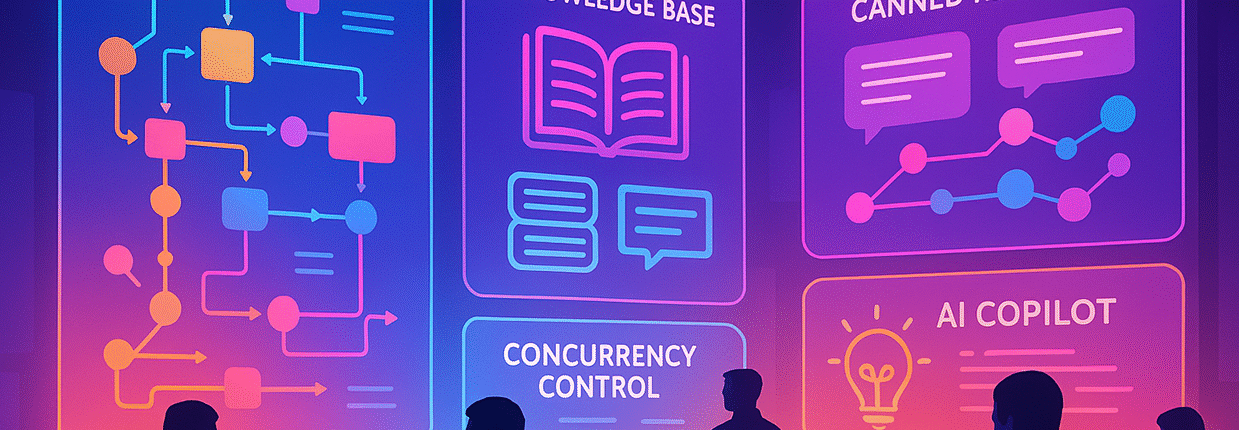Cómo Administrar un Chat Center Eficiente
You roll out the new platform. AI-powered suggestions, unified dashboards, real-time analytics. Your team attends the training. They nod. They ask questions. Three months later, they’re still logging into the old system.
This is the moment when most managers think they have a personnel problem.
They don’t. They have a trust problem.
I’ve spent years watching businesses wrestle with conversational commerce, and I’ve learned something: the technology is never the hard part. Getting humans to trust the technology—that’s where everything falls apart.
The 45% Problem You Should Tackle First
Gartner found that 45% of contact center agents actively avoid new technologies. Not passively ignore. Actively avoid. They find workarounds. They cling to legacy systems. They smile in meetings and then do exactly what they’ve always done.
But here’s what the research also revealed: it’s not the technology they’re avoiding. It’s the uncertainty.
When you leave the old system accessible “just in case,” you’re not being kind. You’re making a declaration: “I’m not confident this new way will work.” Your team hears that loud and clear. So they hedge their bets. They keep one foot in the comfortable past while you drag them toward an uncertain future.
The data doesn’t lie. Agents who retain access to old systems months after rollout use them significantly more than those who don’t have that option. We create the resistance we complain about.
Kill the old system. Set a date. Communicate it. Then do it.
Not because you’re heartless, but because clarity is kindness.
What Fear Actually Looks Like in a Chat Queue
Your agents aren’t afraid of the new software. Let me tell you what they’re actually afraid of:
The typing indicator. That moment when a customer is waiting, watching three dots blink while the agent fumbles through an unfamiliar interface. The shame of incompetence, broadcast in real-time.
The AI shadow. Every chatbot you introduce is a silent question: how long until this replaces me? You can say “AI assists you, it doesn’t replace you” until your voice goes hoarse. But if you haven’t shown them how they become more valuable alongside AI, those are just words.
The surveillance state. Modern chat platforms track everything. Every pause. Every transfer. Every customer satisfaction score. If agents believe those metrics exist to punish rather than improve, they’ll resist with every fiber of their being.
Your competence. Here’s the fear nobody mentions in polite meetings: agents wonder if you know what you’re doing. Is this another flavor-of-the-month that will be abandoned after everyone suffers through the learning curve?
Fear isn’t irrational. It’s lack of information. Listen to it.
The Metric That Murdered Customer Service
I worked with a chat center manager once who worshipped at the altar of Average Handle Time. His team was crushing it—sub-3-minute average across the board. Beautiful numbers. Dashboard perfection.
Customer satisfaction was in the basement, and nobody could understand why.
Then someone actually read the transcripts.
Agents were rushing conversations, copying canned responses, marking issues “resolved” while customers were still confused. They weren’t solving problems. They were processing “tickets”. The metrics looked gorgeous while real customer service sucked.
Here’s what Christina McAllister from Forrester said: “Chat is fairly easy to deploy… The recipe for success is all in the how it is deployed.”
The “how” is understanding that every metric you emphasize creates a behavior. Measure speed, you get speed. Measure satisfaction, you get agents gaming surveys. Measure both equally without clarifying priority, you get paralyzed agents who don’t know what matters.
The solution isn’t abandoning metrics. It’s measuring with intention.
Track First Response Time and Resolution Time, but pair them with First Contact Resolution and actual customer feedback. Monitor agent productivity, but also monitor agent well-being and turnover. Because burned-out agents don’t create happy customers, no matter what your dashboard claims.
Your metrics should serve your mission. When it’s reversed—when the mission serves the metrics—you’ve lost the plot.
Structure Is a Verb, Not a Noun
Most companies structure their chat centers based on what worked when they had five agents, even though they now have fifty. Or they copy their phone support structure and wonder why chat feels different.
Chat is different.
Phone agents handle one conversation at a time, sequentially. Chat agents juggle three conversations while consulting knowledge bases, checking with supervisors, and remembering which customer wanted the blue widget and which wanted the red one.
The cognitive load isn’t just higher. It’s a different kind of higher.
For mid-sized operations (15–30 agents), you need team leads. Not managers with fancy titles—real team leads who remember what it feels like to have five chat windows open while someone asks you to update a report.
Team leads are shock absorbers. They handle day-to-day coaching, quick questions, the “which script for this weird situation?” moments. They free managers to actually manage: spotting trends, optimizing processes, planning for growth instead of fighting fires.
At enterprise scale, you need specialization. Technical support chats require different skills than sales chats. VIP customers deserve agents who navigate complexity without escalating every decision.
But here’s what most companies miss: structure should match the customer journey, not your org chart.
When a customer starts on WhatsApp asking about a product, moves to Instagram to check your posts, then returns to WhatsApp to buy, they shouldn’t feel like they’re talking to three different companies. Your structure should enable continuity, not prevent it.
Structure is how you serve customers, not how you organize headcount.
WhatsApp Didn’t Just Change the Channel—It Changed the Game
Operating in Latin America requires understanding something fundamental: chat isn’t just another channel here. It IS the channel.
In Brazil, 93% of internet users live on WhatsApp. Not “check occasionally.” Live. They talk to their mother there. Their boss. Their friends. Your business.
When a Latin American customer messages you on WhatsApp, they’re not making a strategic choice to “use the chat channel.” They’re breathing. This changes everything.
WhatsApp in LATAM is a sales channel that happens to do support.
Seventy-five percent of consumers who message a business on WhatsApp end up purchasing.
If your LATAM chat center is structured purely for support, you’re abandoning revenue.
Expectations differ. LATAM customers expect warmth, personality, conversation.
Your North American imported script that cuts straight to business feels cold.
Your agents need permission to use names, acknowledge context, add an emoji without fearing they’ve violated corporate policy.
Timing matters differently. WhatsApp is “always-on” in customers’ minds.
Close at 6 PM and you’re not just shutting down for the day—you’re announcing you’re not serious about serving them.
Companies winning in LATAM understand that WhatsApp isn’t a messaging app. It’s digital infrastructure. Where commerce lives. Your chat center isn’t a cost center processing support tickets—it’s your storefront, sales floor, and service desk in one.
The Change Management Playbook That Actually Works
You’ve bought the software. Structured the team. Defined your KPIs. Now comes the part where most initiatives die: getting everyone to use it.
Kill the old system. Not eventually. Not “when everyone’s comfortable.” Set a date—60 days maximum—and honor it. Yes, there will be grumbling. Yes, productivity will dip temporarily. But every day the old system survives, you telegraph that the new way isn’t important.
Train on workflows, not features. Your agents don’t need to know every button. They need to know “how do I handle an angry customer who wants a refund” in the new system. Hands-on practice. Sandbox environments. Real scenarios.
Say the quiet part out loud. In a team meeting, acknowledge the unspoken: “Some of you worry this system will micromanage you. Here’s exactly how we’ll use the data and how we won’t.” Or: “I know there are concerns about AI replacing jobs. The truth is we’re using AI for repetitive work so you can focus on problems requiring human judgment.”
Silence around fear doesn’t eliminate it. It metastasizes.
Create champions, not victims. Identify early adopters who pick up tech quickly. Make them heroes. Title them Super Users or System Champions. Have them mentor peers. Most important: listen when they say something’s clunky and fix it fast.
Celebrate small wins loudly. When First Response Time drops ten seconds because of the new platform, announce it. When a customer leaves glowing feedback about an interaction that used the AI suggestion feature, share it.
Success breeds adoption. Association matters.
Practical Hacks That Move Mountains
Some tactical changes deliver disproportionate results:
- Centralize knowledge ruthlessly. If agents open three systems to find an answer, each system is friction. One unified knowledge base, searchable, current, integrated into the chat interface. This alone can cut resolution time 20–30%.
- Curate canned responses like they’re sacred texts. Pre-written responses work for consistency and speed, but only if they’re used. Audit quarterly. Delete what nobody uses. Update what sounds robotic. Let your best agents contribute. A canned response library is a living tool, not a relic.
- Adjust concurrency dynamically. During simple queries or slow periods, let agents handle 3–4 chats simultaneously. During peaks or technical issues, dial back to 1–2. Flexibility prevents both boredom and burnout.
- Deploy AI as copilot, not replacement. The best AI tools suggest responses or articles. The agent makes the final call. This keeps humans in control while reducing the cognitive load of information hunting.
- Gamify carefully. Friendly competition boosts energy—“highest CSAT this week earns bragging rights”—but don’t gamify metrics that encourage bad behavior. Never reward fastest resolution time if it sacrifices quality.
What I Wish I’d Known at the Start
If I could talk to my younger self—the one convinced that better software would solve everything—I’d say this:
- Your team isn’t resisting tools. They’re resisting uncertainty.
- Your customers aren’t demanding perfect responses. They’re demanding to be heard.
- Your metrics aren’t showing reality. They’re showing what you decided to measure.
And that daily feeling of overwhelm—balancing speed and quality, efficiency and empathy, company needs and team well-being? That’s not failure. That’s the job. The tension is the work.
Successful managers don’t resolve that tension. They learn to live in it, make decisions despite it, support their teams through it.
Running an efficient chat center is hard because it’s fundamentally a human endeavor wrapped in technology. Technology helps or hurts, but it can’t replace judgment, empathy, and adaptability that only humans bring.
Your job isn’t eliminating humanity from the system in pursuit of efficiency. Your job is building systems that amplify humanity while managing chaos.
The Days When Everything Breaks
Some days the new software glitches. Agents get frustrated. Customers get angry. Your boss asks why metrics aren’t better.
Running a chat center that balances technology and humanity, speed and soul, metrics and meaning—that’s possible too. Not easy. But possible.
And the fact that you’re here, reading this, caring enough to want to do it right? That counts for something.
It counts for a lot, actually.
Nobody said this would be easy. But someone has to do it. You’re someone who gives a damn enough to do it right.
Keep going.














